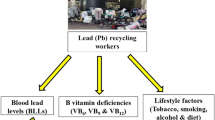Summary
Whole blood lead (Pb-B), urinary δ-aminolevulinic acid (ALA-U) and free erythrocyte protoporphyrin (FEP) were measured in three groups of workers (n = 196) with different degrees of exposure to lead, and one group of men with no previous exposure to the metal (n = 48). Inter-group comparison showed a correlation of r = 0.73 between Pb-B and log of ALA-U, and r = 0.91 between Pb-B and log of FEP. ALA-U and FEP values rose sharply after Pb-B values reached 450–500 μg/1.
Similar content being viewed by others
References
Alessio L, Bertazzi PA, Toffoletto F, Foà V (1976) Free erythrocyte protoporphyrin as an indicator of the biological effect of lead in adult males. I. Relationship between free erythrocyte protoporphyrin and indicators of internal dose of lead. Int Arch Occup Environ Health 37:73–88
Araki S (1978) The effects of water restriction and water loading on urinary excretion of lead, δ-aminolevulinic acid and coproporphyrin. Br J Ind Med 35:312–317
Baloh RW (1974) Laboratory diagnosis of increased lead absorption. Arch Environ Health 28: 198–208
Blumberg MS (1965) Evaluating health screening procedures. In: Lilienfield AM, Gifford AJ (eds) Chronic diseases and public health. John Hopkins, Baltimore
Boeckx RL (1979) The clinical chemistry of lead poisoning. New approaches to an old problem. Clin Proc Child Hosp Natl Med Center 35:216–238
Chisolm JJ, Brown DH (1975) Micro-scale photofluorometric determination of “free erythrocyte porphyrin” (Protoporphyrin IX). Clin Chem 21:1669–1682
Clausen J, Rastogi SC (1977) Heavy metal pollution among autoworkers. I. Lead. Br J Ind Med 34:208–215
Dally S, Duvelleroy M, Conso F, Fournier E (1980) Simulation d'intoxications chroniques: l'exemple du plomb. Arch Mal Prof 41:129–135
Fernandez FJ (1975) Micromethod for lead determination in whole blood by atomic absorption, with use of the graphite furnace. Clin Chem 21:558–561
Grunder FI, Moffitt AE (1979) Evaluation of zinc protoporphyrin in an occupational environment. Am Ind Hyg Assoc J 40:686–694
Hesley KL, Wimbish GH (1981) Blood lead and zinc protoporphyrin in lead industry workers. Am Ind Hyg Assoc J 42:42–46
Joselow MM, Flores J (1977) Application of the zinc protoporphyrin (ZP) test as a monitor of occupational exposure to lead. Am Ind Hyg Assoc J 38:63–66
Karačić V, Prpić-Majić D, Telišman S (1980) The relationship between zinc protoporphyrin (ZPP) and “free” erythrocyte protoporphyrin (FEP) in lead-exposed individuals. Int Arch Occup Environ Health 47:165–177
Lahaye D, Roosels D, Bossiroy JM, van Assche F (1977) The use of the urinary excretion of deltaaminolevulinic acid as a criterion for lead absorption in industrial medicine and insurance medicine. Int Arch Occup Environ Health 39:191–198
Lilis R, Fischbein A, Eisinger J, Blumberg WE, Diamond S, Anderson HA, Rom W, Rice C, Sarkosi L, Kon S, Selikoff IJ (1977) Prevalence of lead disease among secondary lead smelter workers and biological indicators of lead exposure. Environ Res 14:255–285
OSHA (1979) Preamble to final OSHA standards on occupational exposure to lead. Occupational Safety and Health Administration. Part 2, No 404 (Feb. 6th)
Piomelli S (1980) The effects of low-level lead exposure on heme metabolism. In: Needleman H (ed) Low level lead exposure: the clinical implications of current research. Raven, New York
Posner HS (1977) Indices of potential lead hazard. Environ Health Perspect 19:261–284
Přerovská I, Plicková J (1973) Etude critique de diverses fa~ons d'exprimer les taux urinaires du plomb et de l'acide delta-aminolévulinique en milieu hospitalier et en pratique ambulatoire. Arch Mal Prof 34:437–443
Rijks LG (1974) A modification of the Berko-Durko method for the determination of δ-aminolevulinic acid in urine. Clin Chim Acta 53:23–27
Sassa S, Granick JL, Granick S, Kappas A, Levere RD (1973) Studies in lead poisoning. I. Microanalysis of erythrocyte protoporphyrin levels by spectrophotometry in the detection of chronic lead intoxication in the subclinical range. Biochem Med 8:135–148
Seubert A, Seubert S, Nottbohm L, Ippen H (1980) Epidemiological study on the relationships between lead exposure and porphyrin metabolism. Int J Biochem 12:891–895
Tola S, Nordman CH (1977) Subjective symptoms and exposure to lead. Int Arch Occup Environ Health 40:153–162
Vaccaro S, Barghigiani C, Colombetti G, Lenci F, Loi AM, Paggiaro PL, Pagano G, Toma G (1980) The free erythrocyte protoporphyrin assay in monitoring lead-exposed workers. Comparison of two fluorometric methods. Int Arch Occup Environ Health 45:35–48
WHO (1980) Recommended health-based limits in occupational exposure to heavy metals. Technical Report Series No. 647 WHO, Geneva
Zielhuis RL (1975) Dose-response relationships for inorganic lead. I. Biochemical and haematological responses. Int Arch Occup Environ Health 35:1–18
Author information
Authors and Affiliations
Rights and permissions
About this article
Cite this article
Labrèche, F., P'an, A. Relationships between three indicators of lead exposure in workers: Blood lead, δ-aminolevulinic acid and free Erythrocyte Protoporphyrin. Int. Arch Occup Environ Heath 51, 35–44 (1982). https://doi.org/10.1007/BF00378408
Received:
Accepted:
Issue Date:
DOI: https://doi.org/10.1007/BF00378408



